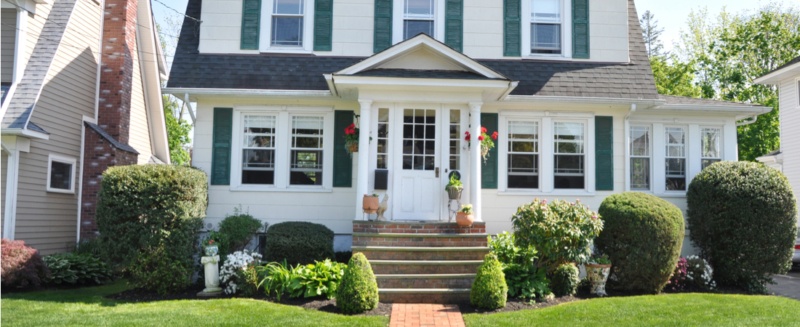Last year, home prices were on the rise, and consumer confidence followed. The upswing in home prices set high expectations for a continued housing recovery, and many homeowners saw a light at the end of the tunnel for the first time in a few years.
Unfortunately, though, not every homeowner was smiling when the year ended. In 2013, homeowners in a handful of markets saw a much smaller rise in their home values than the median. And in some places, homeowners even saw their homes drop in value despite appreciating home prices in the rest of the nation.
Real estate facts: The ten markets where home prices fell the most
According to the Realtor.com database, which has more than 1.7 million listings in 146 markets and measures home list prices, the following 10 markets reported the greatest year-over-year declines in home list prices through December.
1. Akron, Ohio. Akron is one of several Ohio cities that have struggled this year, due in part to the large number of foreclosures that are taking an unusually long time to process. List prices dropped 5.85 percent year-over-year in 2013.
Fortunately, Akron’s economy is strengthening, and its housing market may be headed for better times. Akron’s unemployment rate was only 6.2 percent in December compared to 7.2 percent statewide and 6.7 percent for the nation as a whole.
2. Springfield, Ill. At 8.5 percent, the capital city of Illinois has an unemployment rate slightly above the national average. In 2013, home list prices in Springfield fell 4.09 percent year-over-year. But the outlook is bright for growth, and price increases in 2014 may offset last year’s losses.
3. Shreveport-Bossier City, La. For the second consecutive year, the Shreveport area economy shrank more than any other metro area in the nation—more than 5 percent in 2013. Housing list prices fell 3.58 percent year-over-year, due in part to General Motors’ 2012 decision to close its large assembly plant in the area.
4. Little Rock, Ark. List prices in the Little Rock area fell 3.23 percent year-over-year. But Little Rock’s unemployment rate is below the national average, and job growth in professional and business services, health care, and trade could turn around the housing economy in 2014.
5. Macon, Ga. List prices in the Macon area fell 3.06 year-over-year as the economy continued to struggle. With an unemployment rate of 7.6 percent, University of Georgia economists predict modest job growth for central Georgia in 2014.
6. Harrisburg, Pa. Home sales bottomed out in 2010 as Harrisburg’s population declined, and prices fell 2.65 percent year-over-year in 2013. Despite the dip, though, things have begun to turn around and Harrisburg—with its strong base of state government jobs and 5.6 percent unemployment rate—is expected to grow this year.
7. Albany-Schenectady-Troy, N.Y. Arctic blasts caused home sales in the Albany area to end the year on a frozen note, with list prices decreasing 2.09 percent year-over-year. But local experts expect prices to warm up with the spring thaw.
8. Jacksonville, Fla. After years of misery, the Jacksonville housing market is looking up in 2014, despite a 1.53 percent year-over-year drop in home prices. A slow, steady recovery began in 2012 and continued in 2013. For 2014, that stability is expected to continue across the region.
9. Buffalo, N.Y. Year-over-year prices fell less than 1 percent—0.91 percent, to be exact—in the Buffalo market, which represents a dramatic turnaround from past years. Thanks to a big drop in the inventory of homes for sale, coupled with a rush to get low interest rates before they are gone, Buffalo and Western New York became a seller’s market for the first time in years. Look for the upswing to continue into 2014.
10. Cleveland. Like Buffalo, Cleveland’s 0.85 percent decline in list prices could be considered a victory by the standard of past years. The low decline can be contributed to a low inventory of homes for sale, but this lack of inventory could slow sales. Sales in 2014 are expected to be about where they were last year, possibly a little lower, according to Dan Schuman of the Cleveland Housing News.
Experts predict that 2014 will be a slower year for the housing recovery, with total year-over-year appreciation estimated to be in the range of 3 percent to 4 percent compared to the 10 percent to 11 percent increase in 2013. For some of the markets that did poorly, it could be another tough year. For others, conditions are improving, and it may not be so hard to post some year-over-year price increases.
Steve Cook is executive vice president of Reecon Advisors and covers government and industry news for the Reecon Advisory Report. He is a member of the National Press Club, the Public Relations Society of America, and the National Association of Real Estate Editors, where he served as second vice president. Twice he has been named one of the 100 most influential people in real estate. In addition to serving as managing editor of the Report, Cook provides public relations consulting services to real estate companies, financial services companies, and trade associations, including some of the leading companies in online residential real estate.
[amazon_link asins=’B072BTCMP6,0812925319,B00PEPO9HQ,0609809954′ template=’ProductCarousel’ store=’thinkglink-20′ marketplace=’US’ link_id=’5ac19c31-f64a-11e7-ba87-7bbfb6761683′]






